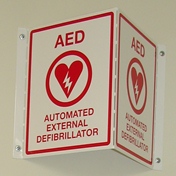Contact Us
UW Safety Office
Hill Hall 654
Laramie, WY 82071
Phone: (307) 766-3277
Fax: (307) 766-4040
Email: uwehs@uwyo.edu
RMMC - Dept 4208
751 N 19th St
Laramie, WY 82071
Phone: (307) 766-3696
Fax: (307) 766-3699
Email: hazmat@uwyo.edu
Public Access Automated External Defibrillators (AEDs)
Public access Automated External Defibrillators (AEDs) are located in many University of Wyoming buildings. This page is offered by Environmental Health and Safety to provide information about AEDs including: what an AED is, the benefit of using it, and how to become certified to use it properly.
Also included are links to: a map of AEDs that are accessible to the UW campus public; resources for individuals interested in becoming certified in Cardio Pulmonary Resuscitation (CPR) in addition to AED use; and also on-campus classes to become a CPR/AED instructor.

What is an AED?
-
An AED (automated external defibrillator) is a device that delivers an electric shock to the heart of a person in cardiac arrest. The device is very simple to operate since it gives verbal instructions on how to use it. All you have to remember is to turn it on. The AED is a "smart" device and will only deliver a shock when it is needed.
-
When a person collapses in cardiac arrest the heart is often in a rhythm called ventricular fibrillation. This rhythm is fatal unless an AED is applied which can stop the fatal rhythm and change it to a normal rhythm. An electric shock delivered quickly by an AED can be life saving.
-
An AED should be used whenever you see a person collapse or become unconsciousness and who does not respond to your shouting or shaking. It should also be used if you come upon a collapsed person even if you didn't see that person collapse.
-
Speed is crucial. The AED must be attached as quickly as possible. Call 911, tell the operator you have an AED and then bring it to the collapsed person. Turn it on and follow verbal directions. Every minute of delay decreases the person's chances of survival by 7% to 10%.
“Public access'' refers to the accessibility of the AED device itself. “Public access” does NOT mean that any member of the public who witnesses a person in cardiac arrest or ventricular fibrillation should use an AED to treat them. While AEDs are reasonably uncomplicated to use, they should be used only by persons who have received proper AED training and education and who have been certified to use an AED by a competent authority.
(U.S.Department of Health & Human Services)
AED locations on campus
- Automated External Defibrillator (AED)/ Emergency Phone Locations
Information and videos on AEDs
The following sites are for your information only. They DO NOT certify you in AED/CPR.
-
The Chain of Survival (Online video course)
This online course explains each step in the Chain of Survival and shows the importance of becoming certified in CPR and AED.
-
Learn AED (University of Washington): http://depts.washington.edu/learnaed/
-
Learn CPR (University of Washington): http://depts.washington.edu/learncpr/
-
Philips HeartStart AED Demonstration (Flash video)
How to get certified in CPR and AED use
Contact Us
UW Safety Office
Hill Hall 654
Laramie, WY 82071
Phone: (307) 766-3277
Fax: (307) 766-4040
Email: uwehs@uwyo.edu
RMMC - Dept 4208
751 N 19th St
Laramie, WY 82071
Phone: (307) 766-3696
Fax: (307) 766-3699
Email: hazmat@uwyo.edu
